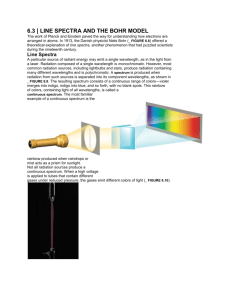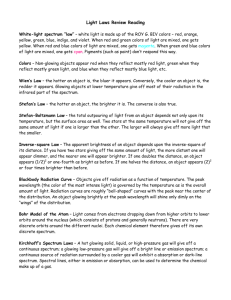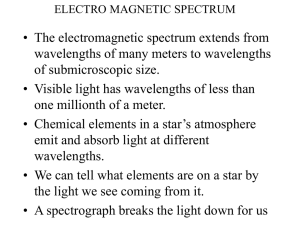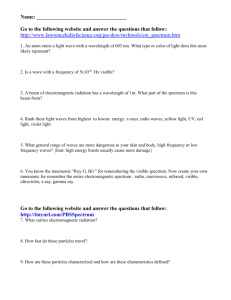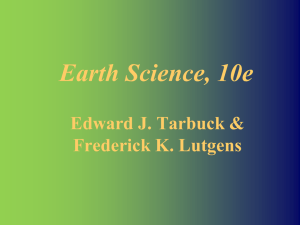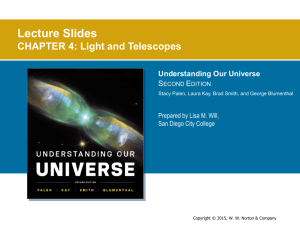2.4 Studying the Sun Guided Notes (#28)
advertisement
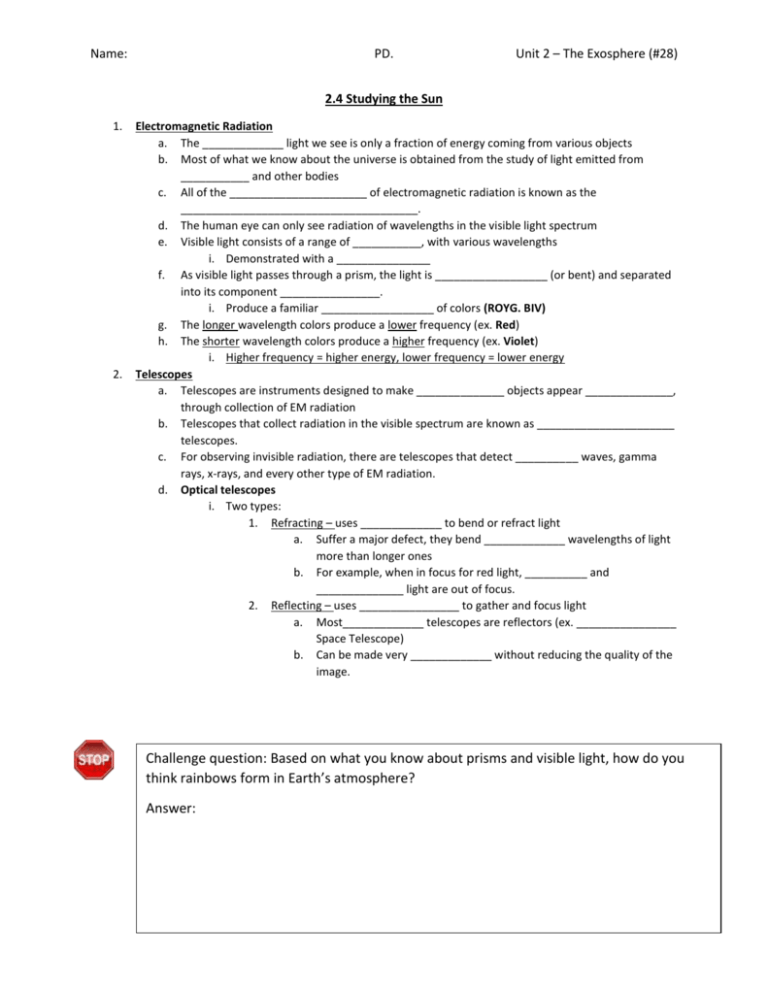
Name: PD. Unit 2 – The Exosphere (#28) 2.4 Studying the Sun 1. 2. Electromagnetic Radiation a. The _____________ light we see is only a fraction of energy coming from various objects b. Most of what we know about the universe is obtained from the study of light emitted from ___________ and other bodies c. All of the ______________________ of electromagnetic radiation is known as the ______________________________________. d. The human eye can only see radiation of wavelengths in the visible light spectrum e. Visible light consists of a range of ___________, with various wavelengths i. Demonstrated with a _______________ f. As visible light passes through a prism, the light is __________________ (or bent) and separated into its component ________________. i. Produce a familiar __________________ of colors (ROYG. BIV) g. The longer wavelength colors produce a lower frequency (ex. Red) h. The shorter wavelength colors produce a higher frequency (ex. Violet) i. Higher frequency = higher energy, lower frequency = lower energy Telescopes a. Telescopes are instruments designed to make ______________ objects appear ______________, through collection of EM radiation b. Telescopes that collect radiation in the visible spectrum are known as ______________________ telescopes. c. For observing invisible radiation, there are telescopes that detect __________ waves, gamma rays, x-rays, and every other type of EM radiation. d. Optical telescopes i. Two types: 1. Refracting – uses _____________ to bend or refract light a. Suffer a major defect, they bend _____________ wavelengths of light more than longer ones b. For example, when in focus for red light, __________ and ______________ light are out of focus. 2. Reflecting – uses ________________ to gather and focus light a. Most_____________ telescopes are reflectors (ex. ________________ Space Telescope) b. Can be made very _____________ without reducing the quality of the image. Challenge question: Based on what you know about prisms and visible light, how do you think rainbows form in Earth’s atmosphere? Answer: Name: 3. 4. 5. PD. Unit 2 – The Exosphere (#28) Spectroscopy a. The study of the ________________ of light that depend on _____________________. b. A _____________________ is a device used to separate light into a spectrum. c. There are _____________ types of spectra, generated under different conditions i. ____________________ spectrum ii. ____________________ spectrum iii. ____________________ spectrum d. When the spectrum of a star is studied, the lines act as “________________” to identify the star’s ___________________ make-up e. Continuous spectrum i. Produced by an ______________________ solid, liquid, or gas under __________ pressure (ex. A common light bulb) ii. Generates an _____________________ band of color f. Absorption Spectrum i. Produced when visible light passes through a _________ gas under _________ pressure ii. Gas ______________ some wavelengths of light, so spectrum looks continuous with some ___________ lines through it. iii. Each _________________ produces a unique set of spectral liens g. Emission Spectrum i. Produced by a _________ gas under __________ pressure ii. Generates bright __________ of certain wavelengths of color, but the rest is _________ Nuclear Fusion a. The way our Sun and other stars produce _______________ b. This nuclear reaction coverts 4 ________________ atoms into a ________________ atom. i. Tremendous _______________ is released c. During nuclear fusion, energy is released because some _______________ is converted into energy. d. Hydrogen atoms are the primary ____________ for fusion in the Sun Matter into Energy a. E = mc2 b. c. d. e. i. E = energy ii. m = ___________ iii. c = speed of ____________ This is known as the Theory of _________________ proposed by Albert Einstein i. It says that a small amount of ______________ can make a large amount of _____________. One of the final products of the fusion of Hydrogen in the Sun is always _______________. Because the speed of light is very great, the amount of energy released from a small amount of __________ is enormous. i. Conversion of one pinhead’s worth of hydrogen to helium releases more energy than burning thousands of tons of coal. Nuclear fusion is not limited to just Hydrogen to Helium i. In hotter stars than our Sun, energy is produced by other elements like _____________, Nitrogen, and Oxygen. Name: 6. PD. Unit 2 – The Exosphere (#28) The Structure of the Sun a. Sun is divided into _________ parts: i. The solar interior 1. Where the energy from _______________ is produced and moves through ii. The VISIBLE SURFACE (Photosphere) 1. Radiates most of the _____________________ we see. iii. The Chromosphere 1. Just above the photosphere 2. Thin layer of hot gases that appear as a _________________ around the Sun iv. The Corona (or Crown) 1. Outermost layer 2. Visible only when the photosphere is _________________ (Total Solar Eclipse) Challenge question: How much longer you think the Sun will likely exist in its present state? Answer:

